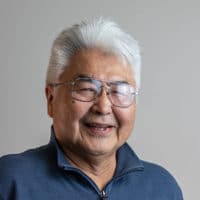Wilson Justin was born in Midcentury at Nabesna Alaska. A village later abandoned to comply with the educational requests of the Bureau of Indian Affairs. The family endured a decade of hardships in Chistochina and Mentasta Village but returned to the homelands for the summer months. As an adventurous youngster, Wilson Justin was prone to chasing shadows and was on the road by the age of fourteen. Threatened with receivership at the Children’s Home in Fairbanks He returned to Mentasta Village in 1965 and soon after followed the rest of the family to Anchorage to finish High School, Graduating from West Anchorage High School in 1968. Right out of High School Wilson volunteered for the Draft with the US Army. The backlist of draftees kept Wilson from a physical until fall of 1969, where to his surprise he failed the physical due to Tinnitus. Not long after he asked for a review of the classification which was 1 Y. In 1973 the Army sent him a letter of response changing the 1 Y classification to 4 F. While waiting for the Army response Wilson spent time in Alaska’s legendary Big Game Business. Once the Army no longer a viable option Wilson began thinking of what kind of a career could be fashioned for an Athabascan with just a high school diploma.
There were no instructions in the sudden transition from a Traditional Society to a one descended from an English speaking world. Wilson had a natural curiosity of the world and soon was able to join the ANCSA Corporation for his region as a Land Planner Trainee in 1977. For many years thereafter Wilson would alternate between the corporate world and the Outdoor Big Game Guiding Business. At the same time Mentors from the Traditional Athabascan world would journey to the Nabesna Country to speak of stories and medicine men of the Headwaters People. Trips to other parts of the region invariably ended up in Stories of the olden times and narrative of wars that occupied the Ahtna Nation prior to Contact. This duel trail of western corporate culture running parallel to the Traditional Teaching became a part of Wilson’s background until the late 1990’s when the last of the Clan Storytellers and Story keepers passed on. It was in this decade that Climate Change began to show its face in his recounting of the times his family lived through Post WW2.
In 1993 after leaving Ahtna Wilson began another quest in a new field. He helped start a Health Organization under Title V, an Act of Congress to allow Tribes to contract Health Services directly with the Indian Health Service. Named to the position of Health Director Wilson represented Mt Sanford Tribal Consortium for 17 years in yearly negotiations with the Federal Government on the meaning, costs, impact, and definition of Health Service in Rural Alaska.
Wilson has advised federal agencies such as US EPA, on issues around environmental program capacity building. In the early 1990’s, US EPA began writing the Indian Environmental General Assistance Program statute (IGAP Act of 1992). Wilson played a critical role in the initial structuring of this program, and in its evolution over the years, as it grew from just a handful of grants to Tribal Governments, to what it is today, with over $27 million dollars in Region 10, Alaska and over 125 Tribes statewide choosing to partner on this program. He has Directed GAP programs, including Mount Sanford’s environmental program, overseeing the development of a successful regional recycling program.
Wilson has professionally attended conferences for decades. He has led numerous discussions on climate change as an acclaimed speaker during interdisciplinary conferences such as the Alaska Forum on the Environment. The publication titled: Alaska Forum on the Environment: Climate Change: Our Voices, Sharing our Ways Forward, became a component to the US Department of the Interior, US Geological Survey, United States National Climate Assessment, Alaska Technical Regional Report (Circular 1379).

